仁爱科普版(2024)七年级英语下册课件 Unit 9 Thinking Skills & Reading Strategies课件(共19张ppt)
文档属性
| 名称 | 仁爱科普版(2024)七年级英语下册课件 Unit 9 Thinking Skills & Reading Strategies课件(共19张ppt) | 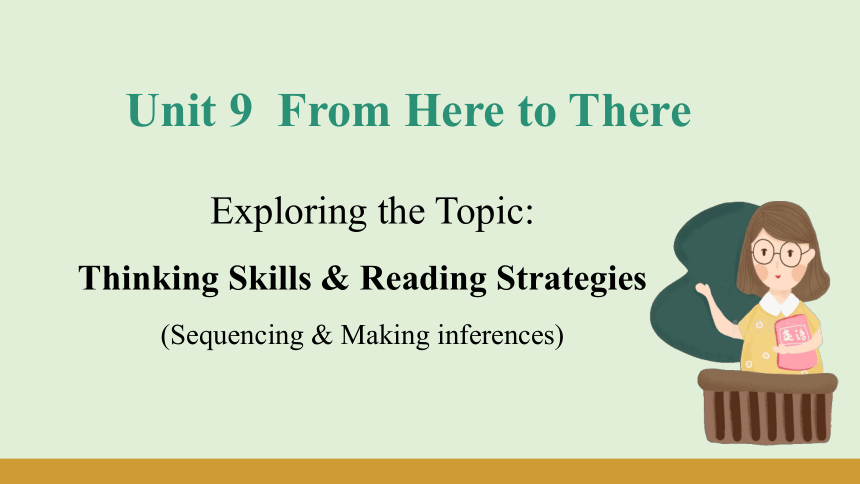 | |
| 格式 | pptx | ||
| 文件大小 | 9.6MB | ||
| 资源类型 | 教案 | ||
| 版本资源 | 仁爱科普版 | ||
| 科目 | 英语 | ||
| 更新时间 | 2025-04-03 20:42:32 | ||
图片预览


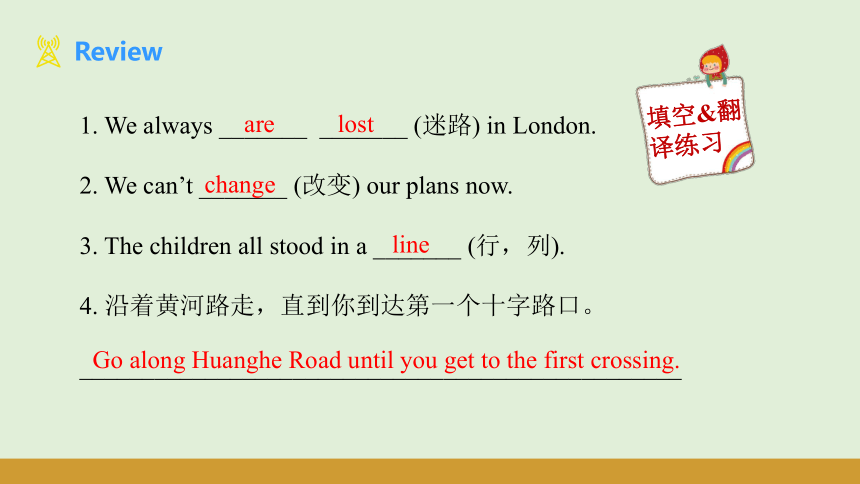
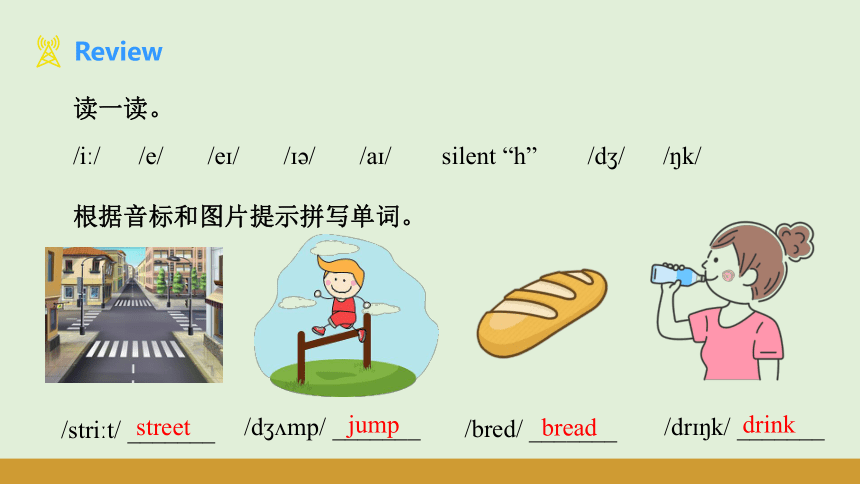
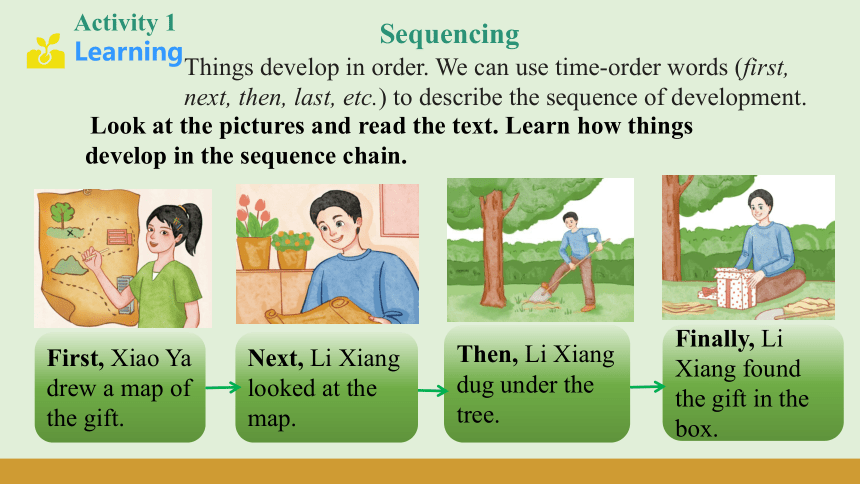

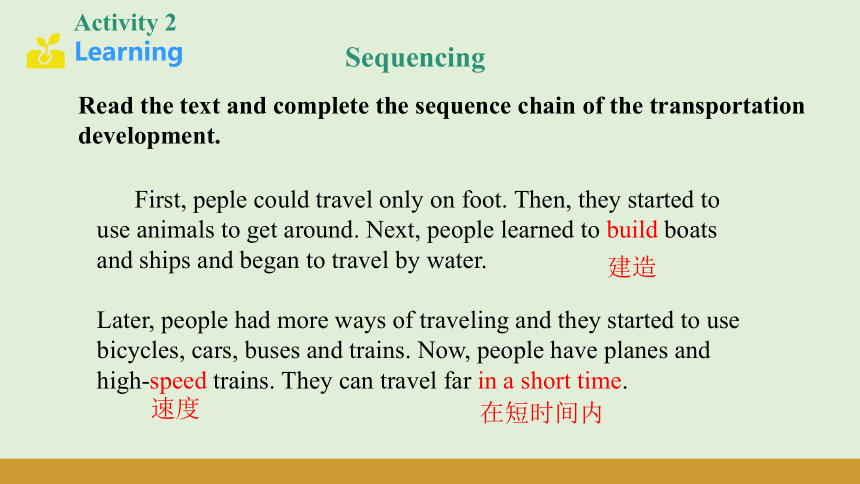
文档简介
(共19张PPT)
Unit 9 From Here to There
Exploring the Topic:
Thinking Skills & Reading Strategies
(Sequencing & Making inferences)
掌握gift、build、speed等词汇;
学会使用表示时间顺序的单词,如first, next, then, finally等,了解事件进展的过程;学会使用推断策略来推导出文本中的隐含信息;
了解交通方式的发展史。
are lost
填空&翻译练习
Go along Huanghe Road until you get to the first crossing.
1. We always _______ _______ (迷路) in London.
2. We can’t _______ (改变) our plans now.
3. The children all stood in a _______ (行,列).
4. 沿着黄河路走,直到你到达第一个十字路口。
________________________________________________
change
line
读一读。
/i / /e/ /e / / / /a / silent “h” /d / / k/
根据音标和图片提示拼写单词。
/stri t/ _______
/d mp/ _______
/bred/ _______
/dr k/ _______
street
jump
bread
drink
Sequencing
Activity 1
Look at the pictures and read the text. Learn how things develop in the sequence chain.
Things develop in order. We can use time-order words (first,
next, then, last, etc.) to describe the sequence of development.
First, Xiao Ya drew a map of the gift.
Next, Li Xiang looked at the map.
Then, Li Xiang dug under the tree.
Finally, Li Xiang found the gift in the box.
n. 礼物;天赋
v. 白送
gift
e.g.
The watch was a gift from my mother.这块表是母亲给我的礼物。
She has a great gift for music.她极有音乐天赋。
They gifted a goal to their opponents.他们白送给对方一分。
Read the text and complete the sequence chain of the transportation development.
Activity 2
Sequencing
First, peple could travel only on foot. Then, they started to use animals to get around. Next, people learned to build boats and ships and began to travel by water.
Later, people had more ways of traveling and they started to use bicycles, cars, buses and trains. Now, people have planes and high-speed trains. They can travel far in a short time.
建造
速度
在短时间内
First
Then
Next
people learned to build boats and ships and began to travel by water.
Later
Now
people
could
travel only on foot.
they started to use animals to get around.
people had more ways of traveling and they started to use bicycles, cars, buses and trains.
people have planes and high-speed trains.
They can travel far in a short time..
Pair work. Talk about the development of transportation by following the sequence chain above.
Activity 3
Sequencing
First Then Next Later Now
蒸汽机车是利用蒸汽机,把燃料(一般用煤)的化学能变成热能,再变成机械能,而使机车运行的一种火车机车。1814年,英国人乔治·斯蒂芬森发明运行了第一台蒸汽机车,从此开始,人类加快了进入工业时代的脚步,蒸汽机车成为这个时代文化和社会进步的重要标志和关键工具。
Sequencing
汉译英。
Making inferences
Then, they started to use animals to get around.
1.这些标志代表地图上的不同地点。
______________________________________________
2.接下来,人们学会了造船,并开始乘船出行。
——————————————————————————————————————————————
3.然后,他们开始用动物四处走动。
———————————————————————
The signs stand for different places on the map.
Next, people learned to build boats and ships and began
to travel by water.
Look at the map signs first, and then follow the steps to learn how to make an inference.
Activity 1
Making inferences
The signs stand for different places on the map.
Step 1: Looking for clues
We can find these places on streets.
Step 2: Thinking about what you know
It is a street map.
Step 3: Making an inference
代表
Making inferences
你可以使用上下文线索(文本、标志、符号等)和
你所知道的东西来弄清楚某事或文本的隐含意义。
You can use context clues (texts, signs, symbols, etc.)
and what you know to figure out something or the implied meaning of the text.
sign
n. 标志,招牌;迹象,预兆
e.g.
a road/traffic sign 道路/交通标志
The snow showed no sign of melting.
雪没有一点融化的迹象。
Making inferences
stand
v. 站立,站起来;容忍,忍受
e.g.
Stand up, please.起立。
Stand still while I take your photo.我给你照相,站着别动。
I can’t stand his brother.他弟弟让我受不了。
Making inferences
Where was the writer On land. At sea.
What was the time of the story In the morning. In the evening.
How did the writer get to the island By boat. By ship.
How did the writer feel in the end Sad. Happy.
√
√
√
√
Activity 2
Read the text and tick (√) the answers.
It was dark, and the wind was strong. I rowed and rowed. Finally, there was an island in front of me. “I’m safe”, I told myself.
Making inferences
dark adj. 黑暗的;昏暗的
row v. 划(船)
island n. 岛
front n. 前面;前部
safe adj. 处境(或情况)安全;安全的
myself pron. 我自己;亲自
evening n. 晚上;傍晚
sad adj. 悲哀的,难过的;令人悲哀的, 让人难过的
in front of … 在……(外部)前面
in the end 最后;最终;终于
Making inferences
Pair plete the table with the clues in the text, and then tell your partner how you make the inferences.
What I can infer The clues I can find
The writer was ________________.
The time of the story was ______________.
The writer got to the island _____________.
The writer felt ____________ in the end.
It was dark, and the wind was strong.
I rowed and rowed.
I rowed and rowed.
“I’m safe”, I told myself.
at sea
in the evening
by boat
happy
Activity 3
We learn:
some words, such as gift, build, speed, etc.
some phrases, such as stand for, in a short time, etc.
the history of transportation.
We can:
use time-order words to describe the sequence of development.
use context clues and what you know to figure out something or the implied meaning of the text.
1. Write a passage to introduce how to plant a tree.
2. Finish the exercises.
Unit 9 From Here to There
Exploring the Topic:
Thinking Skills & Reading Strategies
(Sequencing & Making inferences)
掌握gift、build、speed等词汇;
学会使用表示时间顺序的单词,如first, next, then, finally等,了解事件进展的过程;学会使用推断策略来推导出文本中的隐含信息;
了解交通方式的发展史。
are lost
填空&翻译练习
Go along Huanghe Road until you get to the first crossing.
1. We always _______ _______ (迷路) in London.
2. We can’t _______ (改变) our plans now.
3. The children all stood in a _______ (行,列).
4. 沿着黄河路走,直到你到达第一个十字路口。
________________________________________________
change
line
读一读。
/i / /e/ /e / / / /a / silent “h” /d / / k/
根据音标和图片提示拼写单词。
/stri t/ _______
/d mp/ _______
/bred/ _______
/dr k/ _______
street
jump
bread
drink
Sequencing
Activity 1
Look at the pictures and read the text. Learn how things develop in the sequence chain.
Things develop in order. We can use time-order words (first,
next, then, last, etc.) to describe the sequence of development.
First, Xiao Ya drew a map of the gift.
Next, Li Xiang looked at the map.
Then, Li Xiang dug under the tree.
Finally, Li Xiang found the gift in the box.
n. 礼物;天赋
v. 白送
gift
e.g.
The watch was a gift from my mother.这块表是母亲给我的礼物。
She has a great gift for music.她极有音乐天赋。
They gifted a goal to their opponents.他们白送给对方一分。
Read the text and complete the sequence chain of the transportation development.
Activity 2
Sequencing
First, peple could travel only on foot. Then, they started to use animals to get around. Next, people learned to build boats and ships and began to travel by water.
Later, people had more ways of traveling and they started to use bicycles, cars, buses and trains. Now, people have planes and high-speed trains. They can travel far in a short time.
建造
速度
在短时间内
First
Then
Next
people learned to build boats and ships and began to travel by water.
Later
Now
people
could
travel only on foot.
they started to use animals to get around.
people had more ways of traveling and they started to use bicycles, cars, buses and trains.
people have planes and high-speed trains.
They can travel far in a short time..
Pair work. Talk about the development of transportation by following the sequence chain above.
Activity 3
Sequencing
First Then Next Later Now
蒸汽机车是利用蒸汽机,把燃料(一般用煤)的化学能变成热能,再变成机械能,而使机车运行的一种火车机车。1814年,英国人乔治·斯蒂芬森发明运行了第一台蒸汽机车,从此开始,人类加快了进入工业时代的脚步,蒸汽机车成为这个时代文化和社会进步的重要标志和关键工具。
Sequencing
汉译英。
Making inferences
Then, they started to use animals to get around.
1.这些标志代表地图上的不同地点。
______________________________________________
2.接下来,人们学会了造船,并开始乘船出行。
——————————————————————————————————————————————
3.然后,他们开始用动物四处走动。
———————————————————————
The signs stand for different places on the map.
Next, people learned to build boats and ships and began
to travel by water.
Look at the map signs first, and then follow the steps to learn how to make an inference.
Activity 1
Making inferences
The signs stand for different places on the map.
Step 1: Looking for clues
We can find these places on streets.
Step 2: Thinking about what you know
It is a street map.
Step 3: Making an inference
代表
Making inferences
你可以使用上下文线索(文本、标志、符号等)和
你所知道的东西来弄清楚某事或文本的隐含意义。
You can use context clues (texts, signs, symbols, etc.)
and what you know to figure out something or the implied meaning of the text.
sign
n. 标志,招牌;迹象,预兆
e.g.
a road/traffic sign 道路/交通标志
The snow showed no sign of melting.
雪没有一点融化的迹象。
Making inferences
stand
v. 站立,站起来;容忍,忍受
e.g.
Stand up, please.起立。
Stand still while I take your photo.我给你照相,站着别动。
I can’t stand his brother.他弟弟让我受不了。
Making inferences
Where was the writer On land. At sea.
What was the time of the story In the morning. In the evening.
How did the writer get to the island By boat. By ship.
How did the writer feel in the end Sad. Happy.
√
√
√
√
Activity 2
Read the text and tick (√) the answers.
It was dark, and the wind was strong. I rowed and rowed. Finally, there was an island in front of me. “I’m safe”, I told myself.
Making inferences
dark adj. 黑暗的;昏暗的
row v. 划(船)
island n. 岛
front n. 前面;前部
safe adj. 处境(或情况)安全;安全的
myself pron. 我自己;亲自
evening n. 晚上;傍晚
sad adj. 悲哀的,难过的;令人悲哀的, 让人难过的
in front of … 在……(外部)前面
in the end 最后;最终;终于
Making inferences
Pair plete the table with the clues in the text, and then tell your partner how you make the inferences.
What I can infer The clues I can find
The writer was ________________.
The time of the story was ______________.
The writer got to the island _____________.
The writer felt ____________ in the end.
It was dark, and the wind was strong.
I rowed and rowed.
I rowed and rowed.
“I’m safe”, I told myself.
at sea
in the evening
by boat
happy
Activity 3
We learn:
some words, such as gift, build, speed, etc.
some phrases, such as stand for, in a short time, etc.
the history of transportation.
We can:
use time-order words to describe the sequence of development.
use context clues and what you know to figure out something or the implied meaning of the text.
1. Write a passage to introduce how to plant a tree.
2. Finish the exercises.
同课章节目录
